Aluminum Transporters
Aluminum Transporters (Mobile Assault Bridges, M.A.B.) or Mobile Ferry Assault Bridge (MOFAB) ONLY 2 each remaining, all the other have been sold. Amphibious barges. Dimensions are 42ft overall (the hull is 39' long x 12' wide x 5' 8"high sides ). Full rake forward and half rake aft. The remaining two each have hydraulically controlled marine diesel outdrive propulsion units-which are mechanically shaft driven with hydraulics providing the steering, the tilt and the trim. These barges are less engines and transmissions. Props are a 28 x 28 four blade ni-bral, Kaplan style propeller in a Kort type nozzle. Large Spacious Flat deck. Boat is as stout as it can be and truckable at 12' wide. These currently have four tires on each. The tires can be removed to make it a regular flat bottom barge. Must see, many uses.
OTHERS HAVE THESE EXACT HULLS FOR SALE RIGHT NOW (March 2013) for $50,000 per hull with no outdrives and one guy has one for $75,000, just the cleaned out hull.
Price on these two units is $7,000 each while they last.
Both remaining units are located at 5917 Hwy 90 E, in Broussard, LA 70518.
PLEASE SCROLL DOWN TO SEE ALL THE PHOTOS AND DESCRIPTIONS AT BOTTOM OF PAGE!!!!
Call 985-384-9517 for more information.
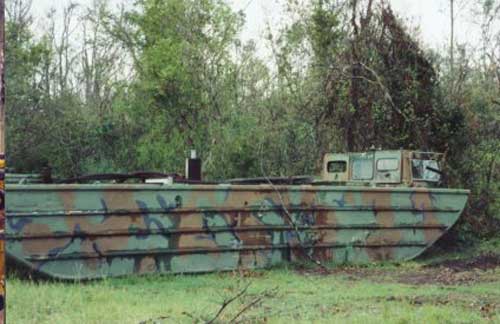
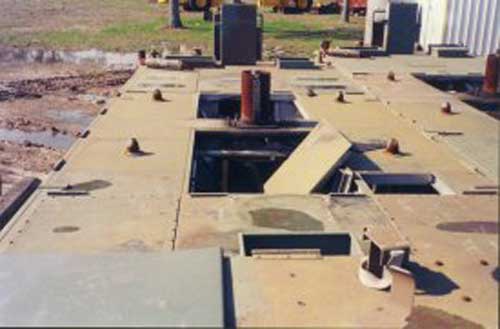
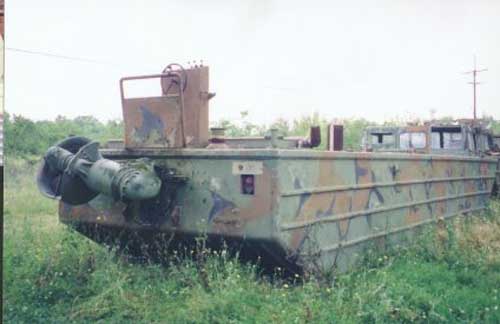
The bows are slightly light and require ballast, either solid or liquid, in the range of 3000-4000 pounds to bring to level.
Alternatively, they beach well when lightened as shown. This unit shown below has a heat exchanger cooled 671N Detroit Diesel engine (210hp) with an Allison direct drive marine transmission (1:1). There is a 2.5:1 reduction in the lower unit (just before the propeller). The outdrive is shaft driven from the marine gear. Although, it could be driven by any rotary power transmission means such as an hydraulic motor, if the operator wants to relocate the engine remote (more forward) in order to bring the boat to level. If the engine is mounted forward, the power can be transmitted to the unit via hydraulic hoses or a longer drive shaft. For most applications the rear mounting of the engine is best because it leaves the majority of the deck plan free and cleared for other uses, such as tankage, storage, deck space, etc..
This particular unit also has a front PTO on the engine which can drive an auxiliary hydraulic pump, an electrical generator or, as in this case a 6" pump which can be used to pump out the tankage (approx 200 barrels in five compartments) or suction from overboard to wash (move floating oil), jet pilings down or fight fires. The five compartments, on this particular barge, all have double bottoms and the large center compartment is double sided also. In addition to the five compartments there are two more, the rakes on each end. The knuckles or chines (bottom corners) are approximately 5/8" thick. On a barge, this is the most critical area for wear, strength and durability. The bottom skin is 3/16"ths as well as the wheel well panels that go from fore to aft. The transverse wheel well panels are 1/8" as are the decks and sides. All compartments have large hatches to access/clean. The hatches are flush multi-bolt with stainless steel thread inserts all around each one. The propeller will stow up to the port side as shown. From that position it can rotate down to a straight vertical position. In the vertical position the bottom of the nozzle surrounding the prop is equal in depth to the bottom of the hull, so that it can sit flat (like in a parking lot) with no blocking up of the hull.
Now from this level the prop will "stretch" or extend the length of it's tube (by about 16"). So that it will be below the bottom of the hull. The prop will also rotate for steering and/or reverse or the unit can be reversed by shifting the gear into reverse. However, if you are stuck on a beach, rotating the prop will provide more thrust than shifting the gear into reverse, because props are made (designed) to be more efficient in forward. With the full nozzle, the outdrive is very efficient and is draft controllable if you get into shallow water. Also, if you get something like a rope or crabtrap stuck in the wheel, you can pull up the propeller to above deck level and look right at it and work on it from the deck level! No sending a man overboard or reaching way out!! If the unit must be towed the prop can be raised to reduce drag. If you are setting the barge down on the ground, the prop can be raised to provide drydocking on any level surface without blocks or a cradle without increasing the total hull length like other outdrives which tilt out (like an outboard motor)!! Outdrives are available on the surplus market at this time, the barges are scarce though!!!
These outdrives also have a shear pin in the linkage below where the enter the hull. This pin will shear if you hit a submerged object while underway, in order to protect the drive. It will kick up like an outboard to protect itself.
Uncle Sam built them like money was no object, why not take advantage of that for your next project. Your grandkids will be operating this equipment! It's that good! The frames are close together and the bottom plate "T" frames are 9" tall!!
The unit below has been sold. It is shown as an example of how the units would look with close mounted power (671 Detroit Diesel) and floating with 3000+ pounds of ballast in the bow.
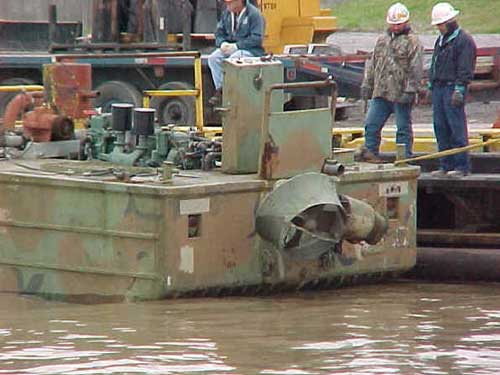
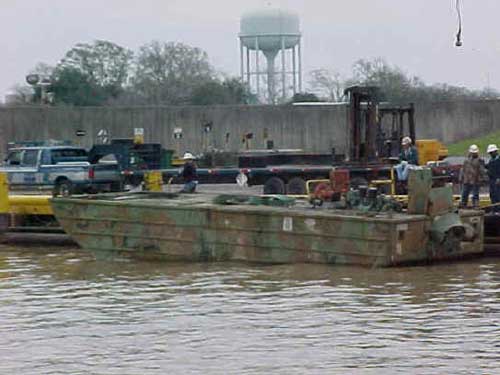


.jpg)
